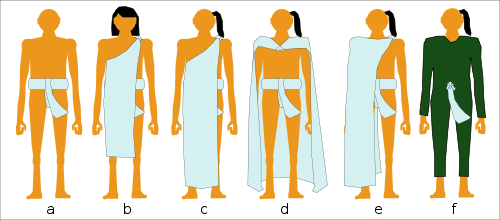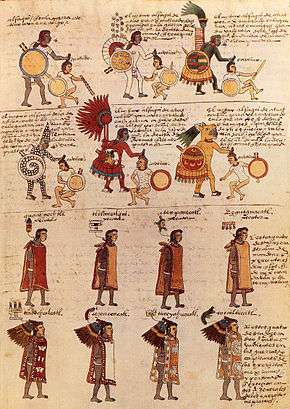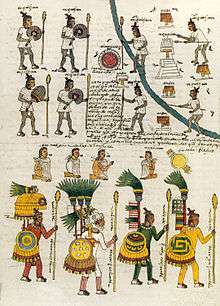Aztec clothing


Aztec clothing is the clothing that was worn by the Aztecs, as well as other pre-Columbian peoples of central Mexico who shared similar cultures.
Everyday dress

The basic garment and braw for males was called maxtlatl[1] [ˈmaːʃt͡ɬat͡ɬ] in Nahuatl. The maxtlatl would often be worn under a cloak or cape called tilmahtli [tilˈmaʔt͡ɬi]; also called tilma in Spanish and English). Various styles of tilmatli existed which served to indicate the status of the wearer.[2]

a: young wearing only a maxtlatl; b: common people (Macehualtin) dress; c: noble (Pipiltin) or high ranking warrior dress; d: ruling classes and the clergy; e: less common way to wear the tilmatli; f: war dress.
Aztec women wore a blouse called huīpīlli[1] [wiːˈpiːɬːi]; also called huipil in Spanish and English) and a long skirt[2] called cuēitl [ˈkʷeːit͡ɬ] (referred to as enredo in modern times). Women kept their skirt on them with a sash[1] called a cihua necuitlalpiloni [ˈsiwa nekʷit͡ɬaɬpilˈu˕ni].[3] In the Classical Nahuatl language, the couplet cuēitl huīpīlli "skirt [and] blouse" was used metaphorically to mean "woman".

The Aztecs wore different clothing depending on their age.[4] Children younger than three wore no clothes.[4] From age three and up, girls wore blouses and boys wore capes.[4] From age four and up, girls additionally wore short skirts.[4] From age five and up, the girls' short skirts was replaced with a longer skirts.[4] At age 13, boys finally started wearing loin cloths.[4]
Sandals, called cactli [ˈkakt͡ɬi], were a sign of status. They were largely restricted to noble males. Those who entered temples or appeared before the emperor were required to be barefoot.
Hairstyles
Aztec women wore hair in two braids that projected in the front like horns[1] and this hairstyle was called neaxtlāhualli [neɑʃtɬɑːˈwɑɬːi].[1] common man hairstyle are cut to the length of the neck and probably a fringe
Jewelry
| Types of Aztec Earplugs Nacochtli [naˈku˕t͡ʃt͡ɬi][3] | ||||||
|---|---|---|---|---|---|---|
| E | N | IPA | English | Nahuatl | Notes | |
| gold | teōcuitlatl | [teu˕ːˈkʷit͡ɬat͡ɬ] | golden earplugs | teocuitlanacochtli | especially prestigious | |
| teōxihuitl | [teu˕ːˈʃiwit͡ɬ] | turquoise earplugs | xiuhnacochtli | especially prestigious | ||
| June Beetle | mayātl | [ˈmajaːt͡ɬ] | green June Beetle earplugs | mayananacochtli | ||
| obsidian | ītztli | [ˈiːt͡st͡ɬi] | obsidian earplugs | itznacochtli | more common, less prestigious | |
| leather | cuetlaxtli | [kʷeˈt͡ɬaʃt͡ɬi] | leather earplugs | cuetlaxnacochtli | awarded to warriors of higher ranks | |
| quetzal | quetzalli | [keˈt͡saɬːi] | curved green ear pendants with bells | quetzalcoyolnacochtli | given to merchants who participated in a conquest | |
| reed | ācatl | [ˈaːkat͡ɬ] | reed earplugs | acanacochtli | ||
| mud | zoquitl | [ˈsu˕kit͡ɬ] | pottery earplugs | zoquinacochtli | ||
| mirror | tēzcatl | [ˈteːskat͡ɬ] | mirror-stone earplugs | tezcanacochtli | ||
| workable metal | tepoztli | [teˈpu˕st͡ɬi] | copper earplugs | tepoznacochtli | ||
| crystal | tehuīlōtl | [teˈwiːlu˕ːt͡ɬ] | crystal earplugs | tehuilonacochtli | ||
| wood | cuahuitl | [ˈkʷawit͡ɬ] | wooden earplugs | cuauhnacochtli | ||
| amber | apozonalli | [apu˕su˕ˈnaɬːi] | amber earplugs | apozonalnacochtli | ||
The Aztec (women and men) would tend to always decorate themselves with gold bangles, necklaces, chokers, etc. Such jewelry was worn to show how wealthy one was; a poor or unwealthy Aztec would tend to wear less jewelry than an Aztec of higher placing and wealth.
The jewelry worn by the Mayan, Aztec, and Inca people was rich in variety and quite beautiful. Without metalworking skills, Mayans made jewelry from many other materials. Mayan men wore nose ornaments, earplugs, and lip plugs made of bone, wood, shells, and stones, including jade, topaz, and obsidian. Necklaces, bracelets, anklets, and headgear were made with jaguar and crocodile teeth, jaguar claws, and feathers. Mayan women and children wore less elaborate necklaces and earrings of similar materials.
Aztecs and Incas perfected metalworking to a great art. Gold and silver jewelry was worn alongside ornaments made of feathers, shells, leather, and stones. Among the Aztecs, laws about which ornaments could be worn were strictly enforced. Only royalty could wear headdresses with gold and quetzal (a bird with brilliant blue-green feathers that reach three feet in length) feathers, for example. The weaving tradition, so important to Incas, helped create beautiful woven headdresses. Inca emperors wore woven hats trimmed with gold and wool tassels or topped with plumes, or showy feathers. Incas also created elaborate feather decorations for men: headbands made into crowns of feathers, collars around the neck, and chest coverings. In addition, wealthy Inca men wore large gold and silver pendants hung on their chests, disks attached to their hair and shoes, and bands around their arms and wrists. Inca women adorned themselves simply with a metal fastening for their cloak called a tupu. The head of their tupu was decorated with paint or silver, gold, or copper bells.
Battle regalia

All warriors wore loincloths, and basic military armor called ichcahuipilli. When they were recognized by the state for their bravery in battle, their status increased (regardless of original class) and they were rewarded with shell and glass beaded jewelry. If the warrior was more honored or a higher rank, they would wear battle suits called Tlahuiztli; these suits were distinctively decorated for prestigious warriors and members of warrior societies. They served as a way to identify warriors according to their achievements in battle as well as rank, alliance, and social status like priesthood or nobility. Usually made to work as a single piece of clothing with an opening in the back, they covered the entire torso and most of the extremities of a warrior, and offered added protection to the wearer. The tlahuiztli was made with elements of animal hide, leather, and cotton. Warriors were also allowed to wear sandals as they progressed through the ranks.

See also
References
- 1 2 3 4 5 Mursell, I. What did the Aztecs wear?. (n.d.). Mexicalore. Retrieved August 31, 2012, from link
- 1 2 Ancient Aztec clothing. (2012). Aztec-History. The Aztecs used many different types of feathers in their clothing. Retrieved August 30, 2012, from link
- 1 2 Nahuatl Dictionary. (1997). Wired Humanities Project. University of Oregon. Retrieved August 31, 2012, from link
- 1 2 3 4 5 6 Mursell, I. Aztec children's clothes. (n.d.). Mexicalore. Retrieved August 31, 2012, from link